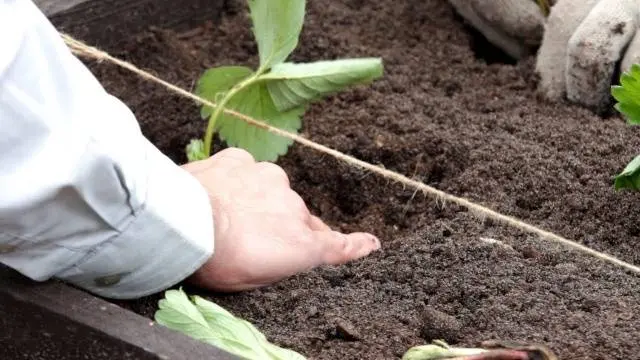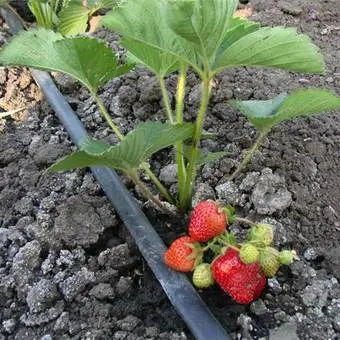Contents
The strawberry variety Mashenka was bred in the Soviet Union 70 years ago. In modern breeding, this garden strawberry can be found under the name Moscow Yubileinaya. Usually, gardeners keep several varieties of sweet berries on their plots at once, selecting them according to their ripening dates. Mashenka will take its rightful place among the early-ripening strawberries, it will delight you with large and very tasty fruits, high resistance to diseases and pests. One of the main advantages of the Mashenka variety is its unpretentiousness to weather conditions: in the difficult climate of Our Country, this strawberry pleases with stable harvests.

A detailed description of the Mashenka strawberry variety, photos and reviews about this berry can be found in this article. And here it will also be told about the rules of agricultural technology, the mandatory stages of care are listed and the strengths and weaknesses of the variety are identified.
Characteristics of strawberries
Strawberry Mashenka is intended for fresh consumption, therefore the variety is recommended for growing in small and medium-sized farms. On a large industrial scale, strawberries are not grown, as the berries are poorly stored and not entirely suitable for processing (due to their large size).
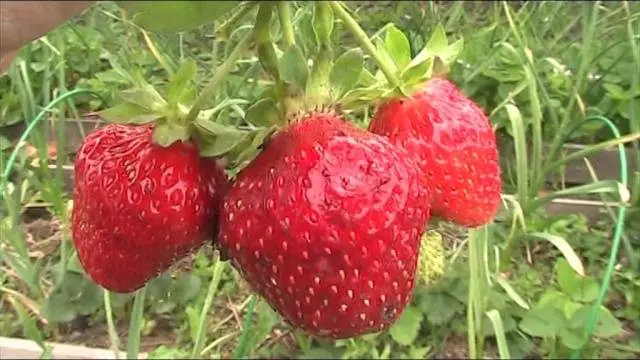
Full description of the Mashenka variety:
- strawberries with early ripening – the harvest ripens in early June;
- bushes are powerful, but compact, not sprawling;
- the leaves are painted in a dark green shade, large, directed upwards;
- inflorescences are complex, often several neighboring flowers are combined into one (this is the reason for the complex shape of the berries);
- the first berries are very large (can reach 120 grams), their shape is like an accordion;
- subsequent fruits are smaller, their shape is cone-shaped, but the mass of strawberries Masha is never less than 30-40 grams;
- if you properly care for the variety, you can get the second crop of Mashenka;
- the color of the berries is rich, burgundy-scarlet;
- the pulp is very dense, sugary, fragrant and tasty;
- the crop tolerates transportation well, strawberries practically do not wrinkle and do not drain for a long time;
- strawberry yield Masha is high – on average, 800 grams per bush;
- mustache formation is average – it is quite possible to propagate this strawberry on your own;
- resistance to diseases and pests is high;
- frost resistance is average – calmly withstands temperatures down to -16 degrees;
- it is recommended to grow Mashenka in open ground or in a greenhouse; the culture is not suitable for indoor cultivation;
- garden strawberries of this variety bear fruit for 4 years;
- strawberries are unpretentious, do not require complex care.
If it were not for the excellent taste of this strawberry, Mashenka would probably have been forgotten long ago. Despite the early ripening and outstanding fruit size, strawberries are very tasty – the tasting score of the berries is 4,4 points.
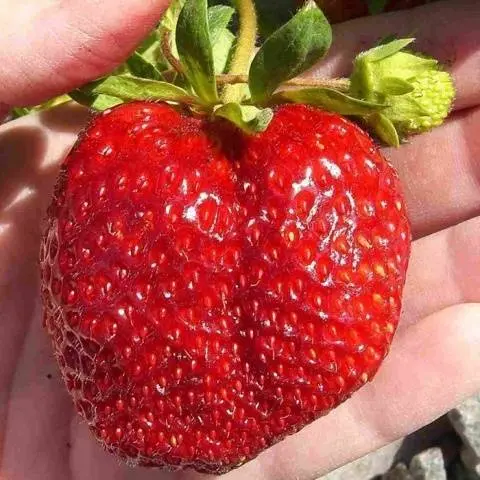
Strengths and weaknesses of the variety
Like any strawberry, Mashenka has its pros and cons. Of course, the main advantage of the variety, which immediately catches the eye, is large-fruitedness – the berries are beautiful, dense, shiny and very large.
This garden strawberry has several other strong qualities:
- high yield;
- excellent taste;
- resistance to diseases and major pests;
- frost resistance;
- compact size of the bush;
- the possibility of growing two crops per season (in the southern regions or in a greenhouse);
- easy breeding by mustache.
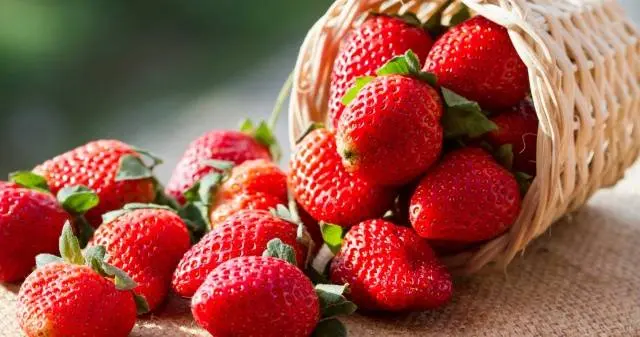
Among the shortcomings of Mashenka can be noted:
- low location of peduncles and berries – so that the crop does not rot, contact of the fruit with the soil must be prevented;
- Mashenka is afraid of the scorching sun, burns may appear on strawberry leaves – the bushes must be shaded;
- the variety is not very hardy (for the central and northern regions of Our Country).
As you can see, the shortcomings of the variety are quite conditional: if you provide strawberries with proper care, they can be completely leveled.
Strawberry Cultivation
It is not difficult to grow Masha, because this variety is unpretentious and gives a lot of whiskers. The culture also does not require special care, so strawberries are suitable for summer cottages and country gardens, which are rarely visited by the owners.
Below is a detailed instruction for growing strawberries of this variety with photographs and a description of each stage.
How to propagate
Strawberry Mashenka reproduces in two ways: by mustache and seeds. Both of these methods are successfully used by gardeners to increase the number of bushes in their own garden, update strawberry beds or grow seedlings for sale.
It is better to buy the first seedlings of Mashenka in a good nursery or in a specialized store. Strawberries from unverified suppliers may not be a pure variety, but one of the many hybrids.
To propagate Masha with a mustache, you need to choose the strongest and healthiest bushes with good productivity – the number of berries on the bushes must exceed the number of mustaches. Then, at each highly developed mustache, the first outlet is found and twisted a little to stimulate rooting. The rest of the mustache is trimmed. In a couple of weeks, a full-fledged seedling of strawberries will turn out.

It is more difficult to grow strawberry seedlings from seeds, and this process will take a lot of time. But it is the seed strawberries that retain all the maternal genes – the variety is more pure.
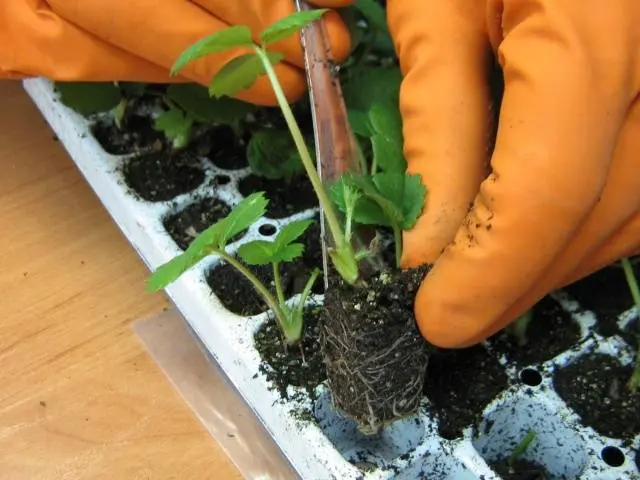
Quality strawberry seedlings should have 6-7 strong leaves, thick shoots and a well-developed root system (as in the photo below).
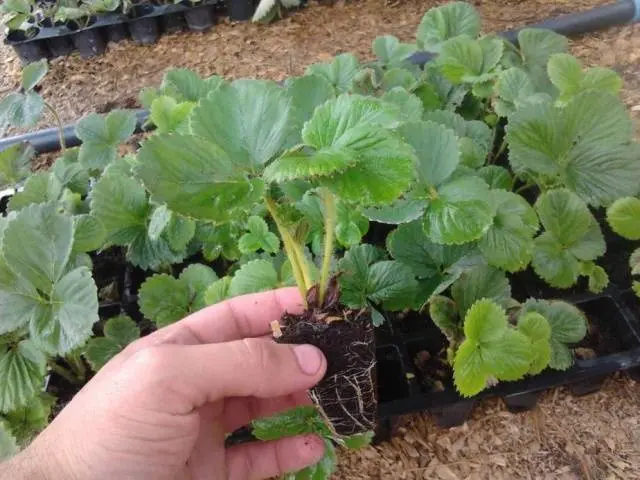
How to plant
Before planting strawberry seedlings, you need to choose a suitable place for it in the garden. Masha, like other berry crops, needs the sun. At the same time, as already mentioned in the description of the variety, scorching rays are contraindicated for it – burns in the form of dark spots will appear on the leaves.
It is necessary to observe the following criteria for planting strawberries:
- Masha is susceptible to night frosts, so planting time is chosen either in mid-May or in the last decade of August.
- The soil for this strawberry should pass air well, so coarse sand or humus must be added to the soil before planting.

- Between the bushes should be left at least 40 cm. In the aisles, the interval should provide comfortable conditions for care and harvesting – at least 50 cm.
- In order for Masha to better adapt to the beds, the roots of the seedlings are carefully straightened, and the growth point is left above the ground.
- Immediately after planting, strawberries are thoroughly watered and the ground is mulched to retain moisture in the roots for a long time.
Strawberry Mashenka takes root well in a new place, so it is quite easy to start and propagate it. Strawberries begin to bear fruit quickly (during spring planting – in the same year).
How to care
The Mashenka variety was bred in Soviet times, when complex methods of growing strawberries were not yet practiced (on agrofibre, under film, on high beds, etc.). Therefore, this culture is unpretentious, it does not need any complex agricultural practices.

You need to care for planting strawberries like this:
- In the first year after planting, seedlings are not fed – pre-planting soil preparation is enough for her. In subsequent seasons, strawberries are fed twice a year, using organic matter and mineral complexes. It should be taken into account that Masha loves slightly acidified soils and does not tolerate excess nitrogen.
- Strawberries need regular watering, especially if the summer is dry and hot. Mashenka prefers drip irrigation. If there is no such system in the garden, you can water the strawberries under the root or through the channels.

- Mulching the ground around the bushes is not only to keep moisture in the ground. The berries of the Mashenka variety often lie on the ground, which causes rot to appear on them, and the mulch will prevent unwanted contact of the fruit with the ground. Sawdust of coniferous trees, straw, dry grass, humus, peat are suitable as mulch.
- If there is too much precipitation during the season, you need to cover the strawberries with a film. If this is not done, the fruits will simply rot.
- It is better to pick berries with stalks Then they don’t drain as fast. Masha should be harvested at intervals of three days. No more than two kilograms of fruit are placed in each container, otherwise the strawberries will choke.
- After harvesting, you can trim the mustache on the bushes if strawberry propagation is not expected.

- Before frosts, it is better to spud the bushes, sprinkle them with humus or dry leaves, sawdust. When snow falls, it is collected and a protective mound is thrown over the strawberries.
Reviews of gardeners
Conclusion
Strawberry variety Masha is time-tested. This garden strawberry is loved and appreciated for its excellent taste, unpretentiousness, adaptability to local climatic conditions.
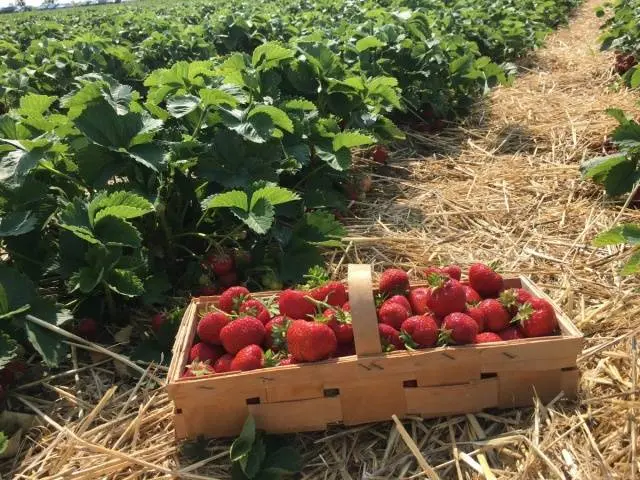
Although the old variety is inferior to fashionable hybrids in terms of yield or beauty of berries, Masha has been taking pride of place in the gardens of the country for many years.










